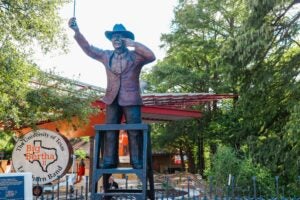“Having a real refrigerator? Like, a full-sized refrigerator? It’s gonna be HUUUGE! It’s gonna change everything for me,” says studio art senior Wes Holloway.
After years of having to use a dorm-sized refrigerator, “I can have wine and beer now…if I want to,” he says smiling, wearing a T-shirt with a cartoon of a smiling vitamin and grinning cupcake holding hands. He’s shifting around in his chair at the Texas Expresso, hair rumpled as only an art student can fashion.
“No, but seriously,” he says, “it really is gonna change everything for me.”
Standard-size refrigerator ownership is just the beginning of what graduation this May from The University of Texas at Austin will mean to Holloway. This spring is the start of a long series of old but new experiences for Holloway. He expects to face a lot of the same challenges most graduates face, making the transition from living in “the UT bubble” as he puts it, into the world to find a job that will pay him for his art. But he also has some other major, life-transforming decisions to consider, like going from a manual to automatic wheelchair, using a keypad on his new house instead of a traditional lock and driving for the first time in six years.
Holloway and his older brother Travis, also a University of Texas at Austin graduate, grew up in Katy, Texas, just outside Houston. Both excelled in athletics and art, and their parents supported their endeavors. Holloway pursued drafting and swimming, but despite his natural talent in art, he enrolled as a natural science major. He continued to draw, sketch and doodle, but seriously pursuing art as a study and as a career didn’t look like a possibility.
That all changed after an accident at a party his freshman year, in spring 2003, left Holloway paralyzed from the chest down.
After several weeks at Brackenridge Hospital, Holloway returned home to Katy to recover. While in physical therapy, it came up that he knew how to draw well and had won awards. His therapists wanted to see some of his work. Holloway asked one of his therapists for a sheet of paper and a pencil and went off into a room by himself to draw, to see if he could still create art in his own style as he did before the accident. Holloway is unable to move his hands, but he figured out he could thread a pencil or paintbrush through his hand. Not only could he still draw, but he found out he could draw in his own style. The first thing he drew was a portrait of his brother, Travis.
Despite having to learn and practice new skills to adapt to his situation, Holloway quickly grew restless in Katy and told his parents he was returning to the university as soon as possible. They were not so sure.
After three months in the hospital and six months in rehab, Holloway came back to the university in fall 2004 and decided to pursue art as his major. He started off in Visual Arts Studies with the intent to teach, but still wasn’t completely happy there. So he made the move to studio art.
“When I told my professor [Sarah Canright] about what I had done, her response was ‘Oh, good! You’re finally where you’re supposed to be.’ And when I took Troy Brauntuch’s class I told him ‘this is all new to me, but I’m willing to try if you are’ and his response was, ‘Well…yes, of course.'”
The matter-of-fact responses from his new professors were a much-needed antidote to the dramatic, sweeping changes from the year past.
Holloway’s hands are unable to move, but they can still command paintbrushes and pencils with astonishing precision and skill, and create amazing works of art on canvas and paper.
His accident left him unable to use his hands, but he still has some use of his wrists and shoulders. Paintbrushes and pencils lie in neat rows on a table next to his canvases. He doesn’t ‘pinch’ them to pick them up so much as he threads or presses them through the spaces between his fingers. His details, his lines, are so fine, they look like they were created with a toothpick. A very small pencil drawing of his in the studio has a bear on a bike, and no detail has been spared. Every perfectly formed, individual tiny claw can be counted.
Holloway’s large-scale oil painting portraiture could be called realism, they so closely resemble photos he takes of his friends, food or objects and situations he finds “gross…but still beautiful.”
Indeed, Holloway’s studio space is surrounded by huge canvases with gaping mouths eating ice cream, bubble gum and cookies. There’s even a still-life with a sopping, greasy cheeseburger. Yet, through Holloway’s eyes, sensibilities and hands, these objects and subjects are beautiful.
Holloway’s determination, diligent practice (he spends about 30 hours a week in the advanced painting studio) and success encouraged his parents to support his choice to pursue a career in art. Because he works on such a large scale, he had to find a way to access his entire canvas. Using a peg board to mount his works required asking people to raise and lower his works for him, so his father made a pulley system using large window blinds that hold his canvases, allowing Holloway to raise and lower the canvases on his own so he can work at his own prolific pace.
Holloway’s work was recently exhibited at the Smithsonian Institute and Kennedy Center in Washington, D.C., and is now part of a touring exhibition titled “Driven.” For Holloway, there could be no more suitable title.



